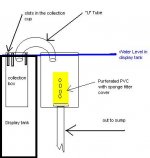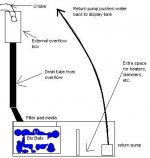I hope this post will explain the HOB overflows.
These devices are fine if your pumping enough water through them for the rating the manufacture suggested for the unit. In other words, you wouldnt want to use a 700g per hour HOB overflow on a 20g tank. You will have problems with to much flow for the tank and a hurricane type effect in the tank If you run the pump required for the unit.
If you use a smaller pump which is under rated for the unit you will have problems with the U tube filling up with air bubbles and breaking the seal... which will flood the room I'll explain the "U" tube more in detail below.
Picture one shows the internal collection cup and the external piece. The internal collection cup has groves cut into the cup to allow water to overflow into the collection cup. You can adjust this internal collection cup up or down to get the water level you wish to maintain in the display tank.
If you notice both ends of the "U" tube are submerged underwater. This allows the pump to be turned off without breaking the seal inside the U tube.
To fill the "U" tube you would first fill the external box with water up to the level of the "U" tube. There is a small chamber on one side of the External box which allows water to pool before flowing over into 2nd part of the external box.
The 2nd part of the external box has the purferated PVC pipe with usually a sponge covering to help keep the holes in the PVC from becoming clogged. This allows flow of water to exit the collection device and drain down to the sump or wet/dry unit.
To fill the "U" tube you insert a small piece of air hose tubing and suck the water over the "hump" of the U tube. Water will start to flow on its own. Make sure you get all the air bubbles out of the "U" tube as these can build up over time and cause the tube to fail resulting in a flood.
There should be a fill line on the wet / dry which gives you an idea how high the water should be. Once you get the water flowing in the U tube and into the wet / dry you want to then start the pump. Everything should flow.
If the display tank starts to overflow the groves on the collection cup portion of the overflow then the water pump is over pumping and you need to cut power back or get a smaller pump.
If the pump pushes to much water out of the wet /dry unit and starts to shoot air bubbles into the display tank you need to allow more water to flow into the wet / dry. this can be done by lowering the internal collection box allowing water to fall into the collection cup quicker. Note your water level will drop in the display tank. You can also add more water volume to the sump if you dont want the water level lower in the display tank from lowering the collection cup.
AFter this has been running and the water levels have adjusted to a "running" level.. (meaning they dont change anymore) you need to test the failover portion of the system.
The return line from the pump has a hole in the end of the tube right before the point where water shoots out into the display tank. This hole should be just at water level or above it.. This hole allows water to keep from flowing back down the return line when the power to the pump is gone. This will prevent your tank from emptying into your wet / dry via that route.
Now to test. Just kill the power to the pump. Water should start to fill up in the wet / dry. You should hear a sucking sound as the hole is exposed on the return flow tube from the pump. THis means water is not flowing backwards into the wet /dry.
Both internal and external portions of the overflow should stay full of water to allow the suction from the "U" tube to maintain.
IF the test is successful you should see the wet / dry fill up but NOT over flow. Make sure you allow enough time to this test as it might take a while for all the water to drain from all the systems parts.
Now just turn the pump back on and you are worry free.
Clean the device expecially the overflow internal and external collection areas at least once a month. It is important that this be free of macro algae, detris buildup and other material that could cuase the until to malfunction.
Check the "U" tube for air bubbles at its peek. There should NOT be bubbles there. IF there are you have the flow rate to low for the HOB unit.
HTH explain more about HOB overflows..
These devices are fine if your pumping enough water through them for the rating the manufacture suggested for the unit. In other words, you wouldnt want to use a 700g per hour HOB overflow on a 20g tank. You will have problems with to much flow for the tank and a hurricane type effect in the tank If you run the pump required for the unit.
If you use a smaller pump which is under rated for the unit you will have problems with the U tube filling up with air bubbles and breaking the seal... which will flood the room I'll explain the "U" tube more in detail below.
Picture one shows the internal collection cup and the external piece. The internal collection cup has groves cut into the cup to allow water to overflow into the collection cup. You can adjust this internal collection cup up or down to get the water level you wish to maintain in the display tank.
If you notice both ends of the "U" tube are submerged underwater. This allows the pump to be turned off without breaking the seal inside the U tube.
To fill the "U" tube you would first fill the external box with water up to the level of the "U" tube. There is a small chamber on one side of the External box which allows water to pool before flowing over into 2nd part of the external box.
The 2nd part of the external box has the purferated PVC pipe with usually a sponge covering to help keep the holes in the PVC from becoming clogged. This allows flow of water to exit the collection device and drain down to the sump or wet/dry unit.
To fill the "U" tube you insert a small piece of air hose tubing and suck the water over the "hump" of the U tube. Water will start to flow on its own. Make sure you get all the air bubbles out of the "U" tube as these can build up over time and cause the tube to fail resulting in a flood.
There should be a fill line on the wet / dry which gives you an idea how high the water should be. Once you get the water flowing in the U tube and into the wet / dry you want to then start the pump. Everything should flow.
If the display tank starts to overflow the groves on the collection cup portion of the overflow then the water pump is over pumping and you need to cut power back or get a smaller pump.
If the pump pushes to much water out of the wet /dry unit and starts to shoot air bubbles into the display tank you need to allow more water to flow into the wet / dry. this can be done by lowering the internal collection box allowing water to fall into the collection cup quicker. Note your water level will drop in the display tank. You can also add more water volume to the sump if you dont want the water level lower in the display tank from lowering the collection cup.
AFter this has been running and the water levels have adjusted to a "running" level.. (meaning they dont change anymore) you need to test the failover portion of the system.
The return line from the pump has a hole in the end of the tube right before the point where water shoots out into the display tank. This hole should be just at water level or above it.. This hole allows water to keep from flowing back down the return line when the power to the pump is gone. This will prevent your tank from emptying into your wet / dry via that route.
Now to test. Just kill the power to the pump. Water should start to fill up in the wet / dry. You should hear a sucking sound as the hole is exposed on the return flow tube from the pump. THis means water is not flowing backwards into the wet /dry.
Both internal and external portions of the overflow should stay full of water to allow the suction from the "U" tube to maintain.
IF the test is successful you should see the wet / dry fill up but NOT over flow. Make sure you allow enough time to this test as it might take a while for all the water to drain from all the systems parts.
Now just turn the pump back on and you are worry free.
Clean the device expecially the overflow internal and external collection areas at least once a month. It is important that this be free of macro algae, detris buildup and other material that could cuase the until to malfunction.
Check the "U" tube for air bubbles at its peek. There should NOT be bubbles there. IF there are you have the flow rate to low for the HOB unit.
HTH explain more about HOB overflows..







